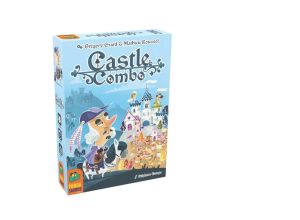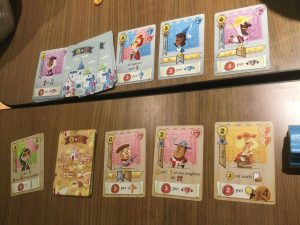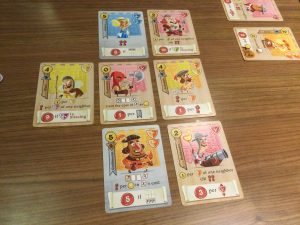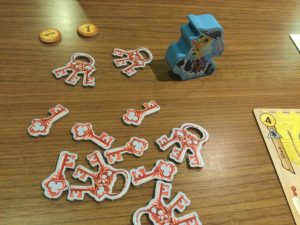| Publisher | Pandasaurus Games |
| Design Credits | Grégory Grard, Mathieu Roussel |
| Art Credits | Stéphane Escapa, Jérôme Soleil |
| Game Contents | 78 cards (39 Castle, 39 Village), Messenger pawn, 52 Gold tokens (40 1-Gold, 12 5-gold), 44 Key tokens (36 1-Key, 8 3-Key), double-sided game reference card, scorepad, rules |
| Guidelines | Card drafting, castle building tableau game |
| MSRP | $24.95 |
| Reviewer | Andy Vetromile |
Grand castles dot the European landscape like privet hedges, but who knew they were all built on a three-by-three pattern? In this entry from Pandasaurus and Catch Up Games, you must arrange your own Castle Combo to lord over.
The object is to score the most points from your castle card grid.
Just as in real life, people are divided into lofty positions of great influence aaand . . . everyone else, relegated to lowly lives of being selected from a different lineup of cards. One row shows three Castle people and the other, a trio from the Village, whence two to five city planners may draft them into their settlement. Cards have a cost in Gold – sometimes that cost is zero – with the higher price tags generally attached to higher-scoring or more utile personages. The Messenger pawn sits beside one of these rows to indicate which set is currently available for purchase. If a player pays a Key he can either remove all three of those citizens and replace them with a hopefully more appealing group, or switch the Messenger to the other lineup and make his purchase there. Should someone find themselves with insufficient funds to afford anything (or to at least buy something they think speaks to their strategy) they can choose any card from their row and flip it facedown into their setup; all of them have a standard “consolation” award of six Gold and two Keys but offer nothing in the way of points.
Every figure in the game offers an immediate benefit when selected, usually a reward of money or Keys (or they might reduce the cost of future buys). They also boost your point total in the endgame with a secondary effect. Some are based on that card’s position in the grid – make sure the character is on, say, your bottom row – while others contribute by giving out bonuses for one’s currency or Keys. As the layout may suggest the whole affair runs nine rounds at which point everyone has a full rack of characters. Endgame points are added to midgame rewards and the highest total wins.
Castle Combo has a pretty straightforward set of components though that’s not the same as cheap. The cards are nice; the Messenger figure is a great, sturdy piece of wood that stands up firmly; and the cardboard tokens are solid as well. Keys come in denominations of both 1 and 3 and the 3s are a standout bit of design/stamping work – just earning one of those is a real pleasure. Much attention has been paid to the character illustrations, and while not everyone will appreciate the cartoonish sensibilities with which they are rendered they are undeniably colorful and interesting. The rules are brief but complete and the rundown they offer gets you right into the game quickly. More than one reference card would have been nice but if it keeps costs down . . .
There’s a fair bit of information to absorb in Castle Combo when establishing one’s grid, try as one must to establish a workable strategy for the game while faced with multiple, often contradictory card benefits. You have to hand it to the designers, they got a lot of info into a small space with these cards without it looking cluttered. Sometimes the colors seem to blend together (the Craftsmanship and Peasantry “shields” are the two specific offenders) making it harder to discern which symbols a character possesses – those icons are another potential points-earner. The symbols themselves being as small as they are don’t help with at-a-glance identification as much as they ought but at least there’s a lifeline available to help the colorblind.
Multiple pathways to victory keeps the game fresh though it’s small and brief enough that it may be relegated to the “filler” or “between other games” categories. That’s not to say unenjoyable by any means because it keeps those neurons tasked with puzzle solving and engine building plenty occupied, and the action is neither trivial nor lacking in robustness. Castle Combo catches the attention easily, learns quickly, and plays smoothly, offering that nice dopamine rush when two or more strategies click together in pleasing fashion – hopefully well enough to mark down a victory.



